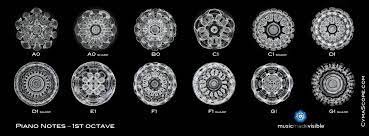Sound is a Bubble, not a Wave
Sound has always been represented graphically and theoretically as a ‘wave’ (Figure 1) which certainly makes scientific observation and conversation simple but can be misleading as to the reality of sound and likely hindering scientific experimentation and thought.
Sound is actually more akin to a bubble, it’s like a dancing and pulsating sphere with complex patterns called cymatics. (Figure 2) Sing “do re mi” as separate syllables and you have three sound bubbles, but don’t think of these bubbles as coming out of your mouth and floating up to the sky, your voice is at the center of this bubble which expands outwards in all directions at approximately 1220 km/h (760 mph). Now realistically our voice is projected forward and so this bubble would likely look more like a mis-shaped oval, with higher pressure (amplitude) moving forward and less so behind the head. If you were to shout outdoors this would typically expand to a sphere of about 1.6kms before becoming too weak to be detected by the human ear.
Understandably it has been much easier to graph and speak about sound as a ‘wave’ but it’s of critical importance to view sound in this way as to be more accurate and not mislead further research and education.
Figure 1
Figure 2: cymascope.com
Reference: The special relationship between sound and light, with implications for sound and light therapy, John Stuart Reid, Subtle Energies and Energy Medicine, Vol 17 No. 3, ISSSEEM.


